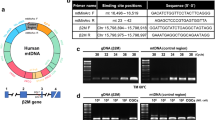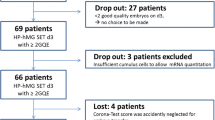Abstract
Purpose
The aim of this study was to establish a simple tool to predict good-quality embryos in in vitro fertilization (IVF) by using cumulus cells (CCs) or peripheral blood cells (PBCs).
Methods
Mitochondrial DNA was extracted from CCs and PBCs in patients undergoing IVF. Using real-time polymerase chain reaction, mtDNA copy number in a single cell was calculated. Embryo quality was assessed when it was transferred or frozen.
Results
CCs were obtained from 60 oocyte cumulus-cell complexes (OCCCs) in 30 women, and PBCs were collected from 18 women. For the 30 women in the study, the median age was 37 years old (range, 24–43), and the mean body mass index was 21.4 (standard error, 2.0). mtDNA content of CCs and PBCs was highly correlated (Pearson’s r = 0.900, p < 0.0001). The median mtDNA content of CCs for good- and poor-quality embryos was 140 and 57, respectively (p < 0.0001). The median mtDNA content of PBCs for good- and poor-quality embryos was 36 and 13, respectively (p = 0.604). The logistic regression model indicated that mtDNA content in CCs was the only parameter that predicted good-quality embryos (p = 0.020). The receiver operating characteristic curve for obtaining good-quality embryos by mtDNA copy number in CCs had an area under the curve of 0.823, and using a threshold of 86, positive and negative predictive values were 84.4 and 82.1 %, respectively.
Conclusions
The determination of mtDNA content in CCs can be used to predict good-quality embryos.



Similar content being viewed by others
References
Balasch J. Ageing and infertility: an overview. Gynecol Endocrinol. 2010;26:855–60.
Keefe DL, Niven-Fairchild T, Powell S, Buradagunta S. Mitochondrial deoxyribonucleic acid deletions in oocytes and reproductive aging in women. Fertil Steril. 1995;64:577–83.
Simsek-Duran F, Li F, Ford W, Swanson RJ, Jones HW, Jr Castora FJ. Age-associated metabolic and morphologic changes in mitochondria of individual mouse and hamster oocytes. PLoS One. 2013;8, e64955.
Van Blerkom J. Mitochondrial function in the human oocyte and embryo and their role in developmental competence. Mitochondrion. 2011;11:797–813.
Chan CC, Liu VW, Lau EY, Yeung WS, Ng EH, Ho PC. Mitochondrial DNA content and 4977 bp deletion in unfertilized oocytes. Mol Hum Reprod. 2005;11:843–6.
Murakoshi Y, Sueoka K, Takahashi K, Sato S, Sakurai T, Tajima H, et al. Embryo developmental capability and pregnancy outcome are related to the mitochondrial DNA copy number and ooplasmic volume. J Assist Reprod Genet. 2013;30:1367–75.
Santos TA, El Shourbagy S, St John JC. Mitochondrial content reflects oocyte variability and fertilization outcome. Fertil Steril. 2006;85:584–91.
Huang Z, Wells D. The human oocyte and cumulus cells relationship: new insights from the cumulus cell transcriptome. Mol Hum Reprod. 2010;16:715–25.
Uyar A, Torrealday S, Seli E. Cumulus and granulosa cell markers of oocyte and embryo quality. Fertil Steril. 2013;99:979–97.
Bonomi M, Somigliana E, Cacciatore C, Busnelli M, Rossetti R, Bonetti S, et al. Blood cell mitochondrial DNA content and premature ovarian aging. PLoS One. 2012;7, e42423.
Hill GA, Freeman M, Bastias MC, Rogers BJ, Herbert 3rd CM, Osteen KG, et al. The influence of oocyte maturity and embryo quality on pregnancy rate in a program for in vitro fertilization-embryo transfer. Fertil Steril. 1989;52:801–6.
Shulman A, Ben-Nun I, Ghetler Y, Kaneti H, Shilon M, Beyth Y. Relationship between embryo morphology and implantation rate after in vitro fertilization treatment in conception cycles. Fertil Steril. 1993;60:123–6.
Teranishi A, Kuwata A, Fumino T, Hamai H, Shigeta M. A theoretical model for single blastocyst transfer. J Assist Reprod Genet. 2009;26:327–34.
Gardner DK, Schoolcraft WB. In vitro culture of human blastocysts. In: Jansen R, Mortimer D, editors. Toward reproductive certainty: fertility and genetics beyond. Carnforth, UK.: Parthenon Publishing; 1999. p. 378–88.
Dumesic DA, Meldrum DR, Katz-Jaffe MG, Krisher RL, Schoolcraft WB. Oocyte environment: follicular fluid and cumulus cells are critical for oocyte health. Fertil Steril. 2015;103:303–16.
Sugiura K, Pendola FL, Eppig JJ. Oocyte control of metabolic cooperativity between oocytes and companion granulosa cells: energy metabolism. Dev Biol. 2005;279:20–30.
Dalton CM, Szabadkai G, Carroll J. Measurement of ATP in single oocytes: impact of maturation and cumulus cells on levels and consumption. J Cell Physiol. 2014;229:353–61.
Dumollard R, Marangos P, Fitzharris G, Swann K, Duchen M, Carroll J. Sperm-triggered [Ca2+] oscillations and Ca2+ homeostasis in the mouse egg have an absolute requirement for mitochondrial ATP production. Development. 2004;131:3057–67.
Bentov Y, Casper RF. The aging oocyte—can mitochondrial function be improved? Fertil Steril. 2013;99:18–22.
McReynolds S, Dzieciatkowska M, McCallie BR, Mitchell SD, Stevens J, Hansen K, et al. Impact of maternal aging on the molecular signature of human cumulus cells. Fertil Steril. 2012;98:1574–80.
Al-Edani T, Assou S, Ferrières A, Bringer Deutsch S, Gala A, Lecellier CH, et al. Female aging alters expression of human cumulus cells genes that are essential for oocyte quality. Biomed Res Int. 2014;2014:964614.
Tsai HD, Hsieh YY, Hsieh JN, Chang CC, Yang CY, Yang JG, et al. Mitochondria DNA deletion and copy numbers of cumulus cells associated with in vitro fertilization outcomes. J Reprod Med. 2010;55:491–7.
Author information
Authors and Affiliations
Corresponding author
Ethics declarations
This prospective study was reviewed and approved by the institutional review board of Hyogo College of Medicine and the Advanced Fertility Center of Fuchu Nozomi (No. 210, approved August 2013). All subjects gave their written informed consent for CCs and/or blood sampling and genetic analysis.
Additional information
Capsule The determination of mtDNA content in CCs can be used to predict good-quality embryos.
Rights and permissions
About this article
Cite this article
Ogino, M., Tsubamoto, H., Sakata, K. et al. Mitochondrial DNA copy number in cumulus cells is a strong predictor of obtaining good-quality embryos after IVF. J Assist Reprod Genet 33, 367–371 (2016). https://doi.org/10.1007/s10815-015-0621-0
Received:
Accepted:
Published:
Issue Date:
DOI: https://doi.org/10.1007/s10815-015-0621-0




